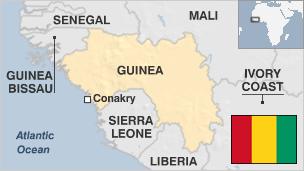
Guinea profile – Overview
-
12 February 2015
- From the section Africa

Although Guinea’s mineral wealth makes it potentially one of Africa’s richest countries, its people are among the poorest in West Africa.
Ruled by strong-arm leaders for much of the time since independence, Guinea has been seen as a bulwark against instability in neighbouring Liberia, Sierra Leone and Ivory Coast. However it has also been implicated in the conflicts that have ravaged the region.
After independence in 1958 Guinea severed ties with France and turned to the Soviet Union. The first president, Ahmed Sekou Toure, pursued a revolutionary socialist agenda and crushed political opposition. Tens of thousands of people disappeared, or were tortured and executed, during his 26-year regime.
Economic mismanagement and repression culminated in riots in 1977. These led to some relaxation of state control of the economy.
But it was only after the death in 1984 of Ahmed Sekou Toure, and the seizure of power by Lansana Conte and other officers, that the socialist experiment was abandoned – without reversing poverty.
In 2000 Guinea became home to up to half a million refugees fleeing fighting in Sierra Leone and Liberia. This increased the strain on its economy and generated suspicion and ethnic tension, amid mutual accusations of attempts at destabilisation and border attacks.
A military junta took control in December 2008 at the death of President Conte.
In 2010, civilian rule was ushered in after a transition period and an election also marred by delays and violent ethnic clashes.
Politics in Guinea typically polarises some two dozen ethnic groups who otherwise live in harmony alongside each other – with the Fulani the largest at around 40% of the population followed by the Malinke and Soussou.
Following elections towards the end of 2013, the European Union announced the resumption of development co-operation which it had suspended since the 2008 coup.
